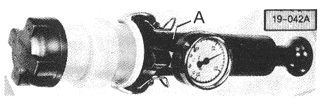Pressure Testing Cooling System and Expansion Tank CapA pressure test will help find any leaks and show whether the cooling system can maintain pressure. If the system cannot maintain pressure, the boiling point of the coolant is reduced and the engine will overheat more easily. Various kinds of cooling system pressure testers are available. Follow the instructions supplied by the tester's manufacturer. The unique design of the Volkswagen system requires a special adapter. If these tools are not available, a Volkswagen dealer or other qualified repair shop can perform this test inexpensively. Pressurize the system to approximately 1.25 bar (18 psi). Loss of pressure indicates leaks which should be apparent by the seepage of coolant. If the pressure drops rapidly and there is no sign of coolant leaks, the cylinder head gasket may be faulty. To check for a faulty gasket, see ENGINE.
To test the cap, install it on the pressure tester as shown in Fig. 3-1. Increase pressure until you hear the cap's pressure relief valve open. On all except the 2.0-liter 16V engine, the valve should open between 1.20 to 1.35 bar (17 to 19 psi). On the 2.0-liter 16V engine, the relief valve should open between 1.3 to 1.5 bar (19 to 22 psi). If the cap's pressure relief valve opens above or below this range, replace the cap.

|